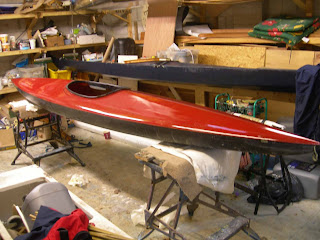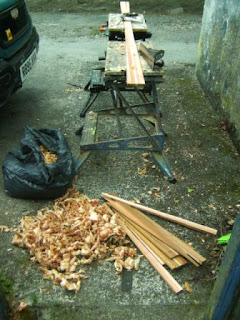If you have an idea - test it!
I am not very keen on the short greenland paddle as a spare - for reasons which will become apparent later in this post and I thought a single bladed might make a good alternative so I set out on Tuesday morning with an ordinary paddle, a greenland paddle, a short (storm) greenland paddle, and an open canoe paddle to see how they compared with each other.
Why a single bladed paddle could be a good idea
Why a single bladed paddle could be a good idea
- Native paddlers use and used them, particularly in Alaska - the Kodiak, Pacific Eskimo, and the people of the Nunvick Island, Bristol Bay, Hooper Bay and King Island where they seemed to use either single or double blades, and the Aleut apparently carried single blades as a spare, although they used a double blade for normal paddling. And then there is the rest of the world...
- Easier to stow than a double blade, they are shorter than a storm paddle and also available for immediate use. Would be short enough to fit on the rear deck.
- They could be drier in use than a storm paddle
- They should be easy to roll with
I used the similar method to what I have used before, noting the speed and time over a fixed course at a constant heartbeat, only as I could not find my monitor I used a constant stroke rate and took my pulse on finishing each leg - number of beats in six seconds. I used the same pulse rate as I had done about five years when I last did this - 100 beats/min. My resting pulse has been about 60 for as long as I can remember.
The setting and conditions
I used a course set between Swanpool and Maenporth Beaches to the west of Falmouth of approx 0.45 nautical miles between two outcrops of rocks and parallel to the shore. I travelled westwards against a F3 breeze from the southwest, for the first leg, and then returned eastwards on the same course with the wind on the quarter for the second leg - two legs, back and forth for each type of paddle. Each leg was done on the same transit using the rocky outcrop as the foreground. The wind raised a steep chop of under 1 ft, parallel to the boat at times with the reflections of the rocks.
The kayak and paddles
I was also using the occasion to sea test one of my Alacrity kayaks which I have been renovating, of note was the higher seat. The boat is 16'6'' x 22 1/4'' and is a greenland type kayak of an extreme swede form.
The paddles used were a pair of obsolete marathon paddles, rather like the old Lendals cut down to 216cm, a greenland paddle 223cm, a short greenland paddle often referred to as a storm paddle and an open canoe paddle.
Results
1. Lendals, going west Stroke rate 60/min finishing pulse approx 90-100, time 7min12 sec, noted on GPS as approx 4kn. Going back to the east, Stroke rate approx 58, same approx pulse rate on finishing , 6min 20sec, noted on gps as approx 4.2kn.
2. Greenland paddle, West 7min 49sec, stroke rate & pulse approx as before, couldn't observe a speed on GPS. east 6min 39 sec approx 4.3 kn at end. Didn't get stroke rate or finishing heartbeat due to tricky quartering chop.
3. Storm Paddle with sliding technique, Going East 7 min 50 sec, approx 3.5kn when noted on GPS, stroke rate approx 50/min, finishing heartbeat approx 100. East 6min 56sec, stroke 42/min, didn't catch heartbeat at end (occasionally as in this case I couldn't find my pulse in time)..
4. Single blade
Not tested but when practicing off Swanpool I was managing less than 3.5kn into the wind - more like 3.2kn. I did not feel sufficiently safe with the single blade to go parallel to the steep reflected chop, as I was having to do a J stroke under the hull to keep on course. I knew that if I went over my GPS would be suspended from the deck lines while I was trying to roll and I didn't want to lose it.
Discussion
The relative speed of the Lendals and Greenland paddle did not surprise me - it was broadly in line with what I had noted when testing before.
What did surprise me was how well the storm paddle performed. Although the stroke rate was slower, the catch was much better as the sliding grip gives a broader more powerful alignment rather like that of the Lendals. Similarly once I had got used to them again the control ( which is better with the GP than the Lendals) was just as good as the full length greenland paddle. What didn't surprise me was how wet they are. As you are gripping the blade which has just emerged from the water, alot of water ends up on the deck - which of course seeps downwards.
I was disappointed with the performance of the canoe blade. I think it was too long and although I have done alot of open canoe paddling, this was the first time I had seriously tried to use the single blade in a sea kayak. Directional control will be a big issue, and of course stability.



Comments
Post a Comment